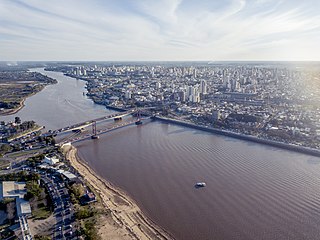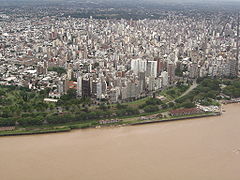
Rosario is the largest city in the central Argentine province of Santa Fe. The city is located 300 km (186 mi) northwest of Buenos Aires, on the west bank of the Paraná River. Rosario is the third-most populous city in the country, and is also the most populous city in Argentina that is not a capital. With a growing and important metropolitan area, Greater Rosario has an estimated population of 1,750,000 as of 2020. One of its main attractions includes the neoclassical, Art Nouveau, and Art Deco architecture that has been retained over the centuries in hundreds of residences, houses and public buildings.

Santa Fe de la Vera Cruz is the capital city of the province of Santa Fe, Argentina. It is situated in north-eastern Argentina, near the junction of the Paraná and Salado rivers. It lies 15 kilometres (9.3 mi) from the Hernandarias Subfluvial Tunnel that connects it to the city of Paraná. The city is also connected by canal with the port of Colastiné on the Paraná River. Santa Fe de la Vera Cruz has about 391,164 inhabitants per the 2010 census [INDEC]. The metropolitan area has a population of 653,073, making it the eighth largest in Argentina. The third largest city in Argentina is Rosario, also located in Santa Fe Province.

Palermo is a barrio or neighborhood of Buenos Aires, Argentina. It is located in the north of the city, near the Rio de la Plata.

Carlos Thays was a French-Argentine landscape architect, and a student of French landscape architect Édouard André.
Departments form the second level of administrative division, and are subdivided in municipalities. They are extended in all of Argentina except for the Province of Buenos Aires and the Autonomous City of Buenos Aires, the national capital, each of which has different administrative arrangements.

Funes is a small affluent city in the province of Santa Fe, Argentina, located within the metropolitan area of Greater Rosario, about 15 km west from downtown Rosario. It has a population of about 23,500 inhabitants.

Lisandro de la Torre is a barrio in the north-east of Rosario, Argentina. It carries the name of a renowned local politician, Lisandro de la Torre (1868–1939), but is most commonly referred to as Arroyito.

Echesortu is a barrio (neighborhood) in Rosario, Argentina. It is unofficially known by that name even though, from the administrative point of view, its name is Remedios Escalada de San Martín. The neighborhood was formerly a town on its own, named after Ciro Echesortu, the original owner of the land; it was absorbed into the city later.

Oroño Boulevard is a street in Rosario, Santa Fe Province, Argentina. It is a two-way boulevard that runs north–south through the center-east of the city, from the coastal avenue by the Paraná River to the southern limit of the urbanized area. Together with the river and with Pellegrini Avenue, it also marks the unofficial limit of the downtown area.

Pellegrini Avenue is a street in Rosario, Santa Fe Province, Argentina. It is a two-way avenue that runs east–west through the center-south of the city, from the coastal avenue by the Paraná River to the western limit of the urbanized area. Together with the river and with Oroño Boulevard, it also marks the unofficial limit of the downtown area.

Córdoba Street is one of the most important streets in Rosario, Santa Fe Province, Argentina. It runs east–west through the center of the city, from the coastal avenue by the Paraná River to the western limit of the urbanized area.

The Parque Urquiza is a public urban park in Rosario, Argentina. It is located in the southeastern end of the city center, on top of the Paraná River ravines. It is bordered by 3 de Febrero St., the coastal Belgrano Avenue, Chacabuco St. and the beginning of Pellegrini Avenue. Its name is an homage to General Justo José de Urquiza, President of the Argentine Confederation from 1854 to 1860.

San Martín Street is an important street in Rosario, Santa Fe Province, Argentina. It runs north–south through the center of the city, from the coastal avenue by the Paraná River to the southern limit of the urbanized area. It was originally named Calle del Puerto ; the name was changed in 1887 to honour Independence War hero General José de San Martín.

Plaza 25 de Mayo is a plaza in Rosario, province of Santa Fe, Argentina. It is Rosario's civic center, and the core of the original settlement. Its name alludes to the date of the May Revolution, which led to the establishment of the first local Argentine government in Buenos Aires. Before 1852, when this name was adopted, it was simply called Plaza Principal.

The Santa Fe Western Railway was an Argentine railway company which became British-owned in 1900 when it was taken over by the Central Argentine Railway. The company was based in the south of the province of Santa Fe.
There are a number of major football rivalries in Argentina.

8N was the name given to a massive anti-Kirchnerism protest in several cities in Argentina, including Buenos Aires, Córdoba, Rosario, Mendoza, Olivos, among many others throughout Greater Buenos Aires and other regions; on 8 November 2012. There were also protests in Argentine embassies and consulates in cities such as New York, Miami, Madrid, Sydney, Bogotá, Santiago de Chile, Naples, Zurich and Barcelona, among others. The protest was considered not only a call to Kirchnerism, but also to the opposition, because they did not have a strong leader.
























